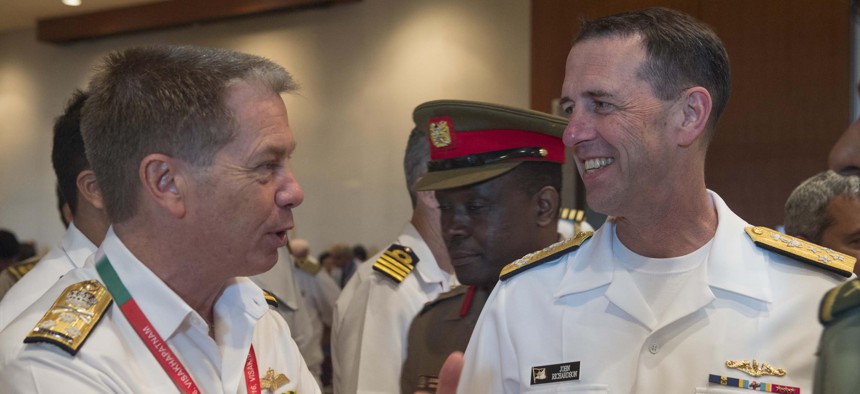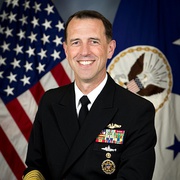
Chief of Naval Operations Adm. John Richardson (CNO) talks with the head of the Royal Australian Navy, Chief of Navy Vice Adm. Tim Barrett, during India's International Fleet Review (IFR) 2016. U.S. Navy / Mass Communication Specialist 3rd Class David Flewellyn
CNO: US Navy Needs Foreign Help Against Russia, China, ISIS, Iran
The Chief of Naval Operations explains why he's working to expand and strengthen the fleet's network of partners.
In January, the U.S. Navy released “A Design for Maintaining Maritime Superiority.” As that document describes, one of our key goals is to expand and strengthen our network of partners. I am looking forward to my participation this week in the Sea-Air-Space Exposition, which provides me an opportunity to engage with a diverse set of partners.
This engagement is particularly important because for the first time in twenty-five years, the Navy is engaged in competition for maritime superiority. As we face this new reality, we must recognize that the Navy is a node in many networks — from our sister services to industry, academia and research facilities, and of course, our international allies and partners. Our Navy will be stronger if we recognize these interconnections and work with both new and established partners to support our mutual interests.
These interests manifest themselves at a time when the fundamental character of the competition has changed: the maritime system is more used, stressed, and contested; the information system is becoming ever more pervasive, and technology is being introduced and adopted at a faster rate. The competitors have also changed: Russia is newly back on the world stage, ISIS has metastasized across the Middle East, China is transforming before our eyes, and the challenges of Iran and North Korea remain. These changes — on both character and competitors — contribute to a maritime environment that is increasingly complex, one that is made even more so by the strong possibility that our budgets will likely be flat or decreasing for the foreseeable future.
Naval Warfare's Future
• With Maritime Superiority at Stake, Navy Must Build Partnerships
• Five Possible Futures for the US Navy
• Naval Cooperation is More Crucial Than Ever. Here’s What It Costs.
• The Lessons of the Littoral Combat Ship
• To Confront Russia's Subs, NATO Must Team Up on ASW Aircraft
One implication of the gap between the demands we see and the resources we expect is that we must do better with what we have. And one the greatest advantages we possess is a constellation of many partners. We must strengthen those ties.
Sea-Air-Space provides an annual platform for us to engage with many of our partners at one venue. We must challenge ourselves to think differently about those partnerships; it is not enough to just get together. We are working hard to make our interactions more purposeful, to engage in conversations about how we can be a better customer, or marry our capabilities with other services (both U.S. and foreign), or provide greater insight into our operational needs so the best minds can dive in to help us tackle our challenges — together.
Since we released the "Design" back in January, I’ve been broadly focusing on improving our Navy’s partnerships here and as I travel. I’ve been spending a lot of time with General Neller and the rest of my service chief counterparts. In addition to our frequent meetings in the Pentagon, we recently spoke together on a panel at the Council on Foreign Relations in New York City. With my foreign counterparts, in addition to multiple meetings in various parts of the world, as well as phone conversations and video teleconferences, I have hosted both the Chilean and Turkish heads of Navy, and traveled to the United Kingdom. In the fall, I’ll be hosting more than 120 nations and dozens of navy chiefs at the International Seapower Symposium, the world’s premier seapower conference.
I’ve also spent time visiting our partners in research and academia, to include Johns Hopkins Applied Physics Lab, Institute for Defense Analyses, and the Center for Naval Analyses. As for industry, I’ve had multiple meetings with the leaders of some of our most important partners in the defense industry, addressed a venture capital summit, and met with the heads of major U.S. manufacturers, finance and other private-sector leaders. I’ve traveled to private shipyards north and south, and have visited companies building some of the most advanced unmanned systems in the world.
The results of these outreach efforts have been positive. The increased interaction is leading to more thoughtful ways of doing business, and I’m reinforcing longstanding relationships and building bridges to new ones. There is much more to do.
During my time at Sea-Air-Space, I will spend time with my counterpart chiefs of America’s maritime services: the Commandants of the Marine Corps and Coast Guard and the Maritime Administrator. I also hope to achieve increased alignment with our international partners, including several chiefs of navy. I intend to deepen our relationship with industry, expand my thinking about what they have to offer, and learn more about how we can improve as a customer.
I look forward to seeing many of you at SAS in the coming days, and to deepening our partnerships as we maintain and grow a Navy that is ready to take on any challenge. We are stronger together!





